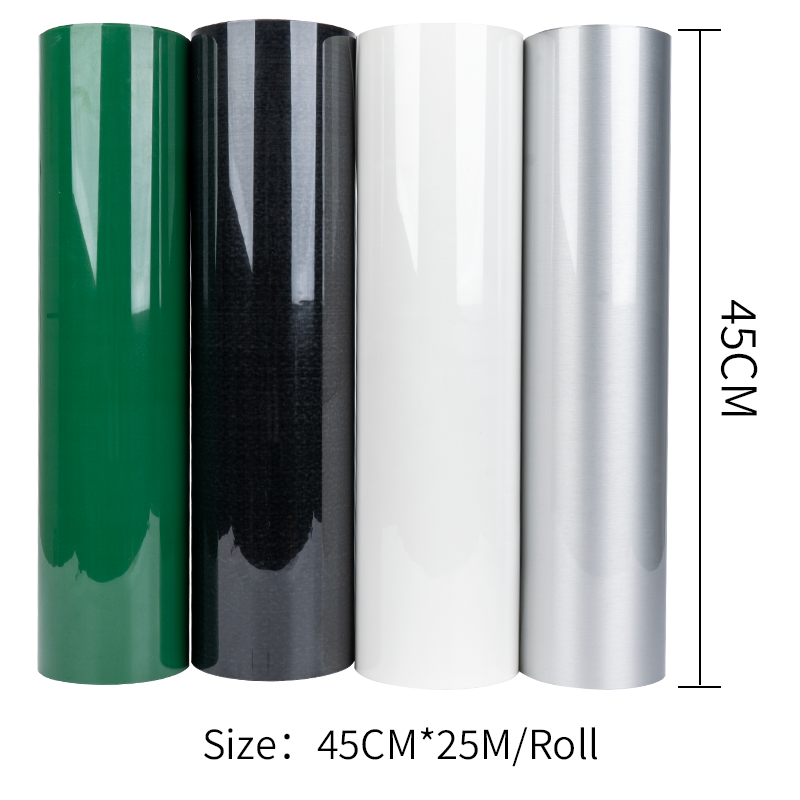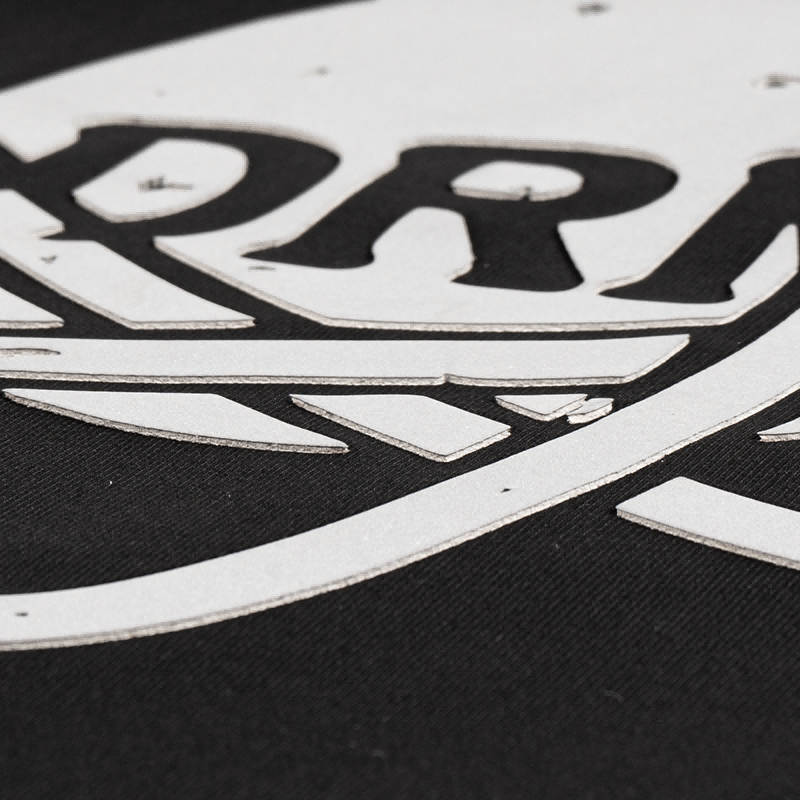가장 두꺼운 3D 열전사 비닐은 무엇인가요?
의류 장식에서 열전사 비닐(HTV)은 의류, 가방, 모자 및 다양한 다른 제품을 맞춤 제작하는 데 사용되는 가장 인기 있는 소재 중 하나입니다. 다용도성, 적용이 용이하며 생생하고 내구성 있는 디자인을 제작할 수 있는 점에서 높은 평가를 받고 있습니다. 가정에서 소규모 공예 프로젝트를 진행하는 경우부터 대규모 의류 생산에 이르기까지 HTV는 맞춤 장식을 담당하는 모든 사람에게 필수적인 도구입니다.
그러나 때로는 단순하고 매끄러운 디자인만으로는 충분하지 않을 때도 있습니다. 작업물이 시각적으로나 물리적으로 두드러지게 나타나길 원하신다면 다음을 사용하는 것을 고려해 보세요. 3D 가장 두꺼운 비닐 열전사 이 특수 HTV는 눈에 띄는 입체적인 효과를 제공하여 어떤 의류에든 고급스러운 느낌을 더해줍니다.
이 가이드에서는 3D 가장 두꺼운 비닐 열전사 어떻게 만들어지고, 무엇이 특유하고, 어떤 혜택이 있는지, 어떻게 잘 적용하고, 어떻게 돌볼 수 있는지에 대한 것입니다. 또한 이 고효과 물질에 대한 가장 일반적인 질문에 대한 답변을 제공하는 FAQ 섹션도 찾을 수 있습니다.
3차원 가장 두꺼운 비닐 열 전달을 이해
3D 두꺼운 비닐 열 전달 용어는 표준 HTV보다 훨씬 두꺼운 열 전송 비닐의 유형을 의미합니다. 일반 HTV의 두께는 보통 80~100마이크론이지만 가장 두꺼운 3D 버전은 300마이크론 이상일 수 있습니다.
이 추가 두께는 압축 후 상승, 부각 된 효과를 만듭니다. 열을 가하는 과정에서 확장되는 펄프 비닐과 달리, 3D 가장 두꺼운 비닐 열 전달은 제조 과정에서 재료에 높이가 내장되어 있습니다. 두께는 일관성 있고 단단해서 최종 디자인이 구조적이고 전문적인 외관을 갖게 합니다.
3차원 가장 두꺼운 비닐 열 전달이 어떻게 만들어지는지
3D 가장 두꺼운 비닐 열 전달은 밀도가 높고 내구성이 높은 구조를 얻기 위해 고품질 비닐의 여러 장을 층으로 만들고 압축하여 생성됩니다. 이 다층 구조는 다양한 직물에 붙을 수 있는 충분한 유연성을 유지하면서 비닐의 높기와 강도를 높여줍니다.
접착제 뒷면은 적절한 열과 압력에 노출되면 단단하게 결합하도록 특별히 구성되었습니다. 두께가 커졌음에도 불구하고, 이 재료는 대부분의 장작 자작기와 플롯터에서 과도한 어려움 없이 잘라낼 수 있도록 설계되었습니다.
3D 가장 두꺼운 비닐 열 전달을 독특하게 만드는 것은 무엇입니까?
여러 가지 핵심 품질이 3D 두꺼운 비닐 열 전달을 다른 유형의 HTV에서 돋보이게합니다.
첫째, 눈에 띄는 높기와 크기가 있습니다. 이 높이는 자연스러운 그림자와 강조를 만들어 멀리서도 디자인을 더 잘 볼 수 있게 합니다.
둘째, 단단하고 체계적인 느낌을 줍니다. 폼이나 부드러운 비닐과 달리 3D 가장 두꺼운 비닐 열 전달은 모양을 유지하고 촉각에 단단합니다.
셋째, 그 내구성은 탁월합니다. 밀집 한 층 으로 만들어졌기 때문 에, 이 비닐 은 더 얇은 선택지 보다 훨씬 더 평평 해지, 균열, 껍질 벗겨지지 않는다.
마지막으로, 톱니 톱니 가 눌러 지은 후에도 날카롭고 깨끗하다. 적용 도중 확장 되지 않기 때문에, 정확성 을 요구하는 디자인 에 적합 합니다.
3D 가장 두꺼운 비닐 열 전달을 사용하는 것의 장점
3D 가장 두꺼운 비닐 열전사는 캐주얼 크래프트 작업자와 전문 디자이너 모두에게 다양한 혜택을 제공합니다.
이 제품은 고급스러운 외관을 구현하여 어떤 디자인도 더욱 가치 있게 느껴지게 합니다. 로고, 글자, 그래픽은 입체적인 형태 덕분에 시각적인 깊이와 질감을 더해 강조됩니다.
가독성도 향상시킵니다. 스포츠 의류나 홍보용 의류에서 이 추가된 입체감은 평면 인쇄물보다 디자인이 훨씬 더 효과적으로 돋보이게 합니다.
다용도성도 또 하나의 장점입니다. 이 비닐은 면, 폴리에스터, 혼방 원단 및 캔버스 등 다양한 종류의 천에 부착될 수 있습니다.
비닐 자체도 오래 지속됩니다. 올바르게 적용된 경우, 여러 번 세탁하고 사용하더라도 형태와 색상, 입체 구조를 그대로 유지합니다.
마지막으로, 다양한 색상과 완성도로 제공되며, 제작자들이 디자인 선택에 유연성을 제공합니다.

3D 가장 두꺼운 비닐 열 전달에 대한 일반적인 사용
3D 가장 두꺼운 비닐 열 전달은 사용자 지정 의류 장식의 많은 분야에서 사용됩니다.
스포츠 의류에서, 그것은 멀리서 볼 필요가 있는 과감한 숫자 및 팀 로고에 이상적입니다.
기업 브랜드화에서, 유니폼과 홍보 의류는 차원 로고로 만들어진 전문적인 이미지에서 이익을 얻습니다.
스트리트 웨어와 패션에서, 높게 된 질감은 특유의 터치를 더하여 일반 디자인보다 호디, 재킷, 티셔츠를 높여줍니다.
콘서트 의류나 축제 장비와 같은 이벤트 상품은 초차원적인 그래픽으로 장식되면 더 기억에 남게 됩니다.
3D 가장 두꺼운 비닐 열 전달을 적용하는 방법
3D 가장 두꺼운 비닐 열 전달을 적용하는 것은 표준 HTV와 비슷하지만 압축 설정을 신중하게 조정해야합니다.
먼저, 디자인 디자인을 호환되는 절단기로 절단하세요. 두꺼운 재료를 다루기 위해 칼의 깊이를 조정하고, 항상 주요 프로젝트를 시작하기 전에 테스트 절단 수행.
다음으로, 과잉 비닐을 제거하여 원하는 부분만 남게 합니다.
유료판을 미리 압축하여 습기와 주름을 제거하여 부드러운 표면을 보장합니다.
모형을 옷에 올려놓고, 모형은 위로 향한다.
제조업체의 권장 온도, 시간 및 압력을 사용하여 압력합니다. 두꺼운 비닐은 일반적으로 표준 HTV보다 단단한 압력과 약간 더 긴 압력이 필요합니다.
압축 후, 수송판을 벗기기 전에 디자인이 식도록 허용하여 들어올림이나 왜곡을 방지합니다.
최상의 결과를 위한 팁
항상 검정 절단으로 刃의 깊이를 확인하고 절단 압력을 확인합니다.
단단하고 균일한 압력을 가하여 두꺼운 물질에 완전히 붙어있는 것을 보장합니다.
과열 을 피 하십시오. 과열 이 vinil 와 fabric 둘 다 를 손상 시킬 수 있기 때문 입니다.
사용 하지 않은 비닐을 시원하고 건조한 곳에 보관하여 품질을 유지하십시오.
3D 가장 두꺼운 비닐 열 전달으로 옷을 관리
적절한 관리가 3D 두꺼운 비닐 열 전달으로 장식된 옷을 가장 잘 보이도록 합니다.
안쪽쪽을 차가운 물이나 따뜻한 물로 씻어주세요.
백제 와 강한 세정제 를 피하십시오.
공기 건조 또는 낮은 열에서 건조.
비닐에 직접 철도 안 해
이 지침 을 따를 때, 비닐 은 수 년 동안 그 의 고장 된 모양 과 활기찬 색 을 유지 할 수 있다.
왜 사람들은 3D 가장 두꺼운 비닐 열 전달을 사랑합니까?
3D 가장 두꺼운 비닐 열 전달의 인기는 어떤 디자인도 눈에 띄고 기억에 남는 것으로 만드는 능력에서 비롯됩니다. 수공가들은 이 제품으로 창조적인 가능성을 누리고, 기업들은 브랜드에 대한 영향력을 높이 평가하고, 소비자들은 고급스러운 외모와 느낌을 높이 평가합니다.
대담하고 크기가 큰 이 제품은 붐비는 시장에서 차별화되어 있으며, 고품질의 뛰어난 디자인을 만들고자 하는 모든 사람들에게 최고의 선택이 됩니다.
자주 묻는 질문
3D 가장 두꺼운 비닐과 펄프 비닐의 차이는 무엇일까요?
3D 가장 두꺼운 비닐 열전사는 눌러 붙일 때 두께가 그대로 유지되는 내장된 단단한 두께를 가지고 있습니다. 반면, 퍼프 비닐은 가열 시 확장되어 더 부드럽고 둥근 질감을 만듭니다.
신축성 있는 원단에 3D 가장 두꺼운 비닐 열전사를 사용할 수 있나요?
예, 하지만 신축성이 최소한인 직물에서 가장 잘 작동합니다. 고신축성 소재에 사용하는 경우 내구성을 향상시키기 위해 신축성 접착 백킹을 사용하는 것을 고려하십시오.
3D 가장 두꺼운 빈일 열전사 제품을 절단하려면 특수 블레이드가 필요한가요?
절단 기계에 따라 더 깊게 절단할 수 있는 블레이드가 필요할 수 있습니다. 본격적인 작업을 시작하기 전에 반드시 테스트 절단을 수행하십시오.
3D 가장 두꺼운 비닐 열 전달은 표준 HTV보다 더 무겁습니까?
네, 더 두꺼우고 밀도가 높은 구조로 인해 더 많은 무게를 가지고 있지만 대부분의 옷 종류에 착용하기에 편안합니다.
3D 가장 두꺼운 비닐 열 전달은 시간이 지남에 따라 찢어질까요?
적절 한 적용 과 관리 를 받으면 찢어지지 않아야 합니다. 장기적인 성능과 내구성을 위해 설계되었습니다.
3D 가장 두꺼운 비닐 열 전달을 다른 종류의 HTV로 층으로 만들 수 있나요?
네, 하지만 착 문제 를 피하고, 상승 효과를 보존 하기 위해 상단 층 으로 가장 잘 사용 됩니다.
가장 두꺼운 3D 비닐 열전달 기계는 씻을 수 있나요?
네, 뒤집어놓고 부드러운 순환으로 씻으면 세탁기에서 안전하게 씻을 수 있습니다.



